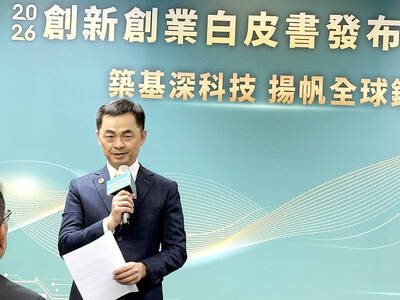Taiwan Semiconductor Manufacturing Co (TSMC, 台積電), the world’s top contract chipmaker, yesterday said it planned to start mass-producing next-generation 450mm wafers using advanced 10-nanometer technology in 2018.
The plan was included in the latest technology roadmap unveiled by TSMC about one year after the chipmaker attributed its delay in making 450mm wafers, originally scheduled in 2015, to semiconductor equipment suppliers’ postponement in developing advanced equipment for manufacturing amid the industrial slump.
The 450mm wafers would help solve the problem of rising costs in making advanced chips, allowing TSMC to provide affordable 10 nanometer chips with FinFET transistors for customers, J.K. Wang (王建光), vice president of TSMC’s operation in charge of 300mm factories, told a media briefing arranged by semiconductor industry association SEMI.
Cost constraints rather than technological constraints for chipmakers to migrate to next-generation chips via shrinking chip geometry, he said.
Chipmakers can get 2.5 times more chips from a 450mm wafer than from a 300mm wafer.
The advanced 10-nanometer chips could first be used in mobile devices and other consumer electronics, like game consoles, that demand high-performance and low power consumption, Wang said.
TSMC planned to build a pilot production line to make 450mm wafers between 2016 and 2017, when semiconductor ASML Holding NV had its key equipment ready in 2015, Wang said.
The chipmaker would consider building major 450mm-wafer production lines in Greater Taichung, he said.
Early this year, TSMC joined the Global 450 Consortium in a move to facilitate the transition of 450mm wafer production from its current 300mm wafers in collaboration with the world’s major chip companies, Intel Corp, Samsung Electronics Co, IBM Corp and GlobalFoundries Inc, Wang said.
Each company sent 20 engineers to jointly develop the technology and overcome challenges, Wang said.
Taiwanese chipmakers are expected to spend 8 percent more on semiconductor equipment to U$9.2 billion this year from last year’s US$8.2 billion, primarily driven by contract chipmakers, TSMC in particular, SEMI analyst Clark Tseng (曾瑞榆) said.
That was a contrast to an annual decline of 2.6 percent in spending by global chip companies this year, SEMI said.
TSMC planned to spend US$8.5 billion on new equipment this year.
Next year, Tseng expects local chipmakers to budget more than US$9 billion in total on new semiconductor equipment, meaning little change from this year’s spending. Any improvement in the macroeconomy would allow an upward revision, he said.
Taiwan and South Korea are expected to be the two largest markets for semiconductor equipment this year, with purchases totaling US$9.26 billion and US$11.48 billion respectively, according to SEMI figures.
TSMC shares rose 0.12 percent to NT$84 yesterday, outperforming the TAIEX’s 0.01 percent gain, while rival United Microelectronics Co (聯電) was flat at NT$11.95.

CHIP RACE: Three years of overbroad export controls drove foreign competitors to pursue their own AI chips, and ‘cost US taxpayers billions of dollars,’ Nvidia said China has figured out the US strategy for allowing it to buy Nvidia Corp’s H200s and is rejecting the artificial intelligence (AI) chip in favor of domestically developed semiconductors, White House AI adviser David Sacks said, citing news reports. US President Donald Trump on Monday said that he would allow shipments of Nvidia’s H200 chips to China, part of an administration effort backed by Sacks to challenge Chinese tech champions such as Huawei Technologies Co (華為) by bringing US competition to their home market. On Friday, Sacks signaled that he was uncertain about whether that approach would work. “They’re rejecting our chips,” Sacks

NATIONAL SECURITY: Intel’s testing of ACM tools despite US government control ‘highlights egregious gaps in US technology protection policies,’ a former official said Chipmaker Intel Corp has tested chipmaking tools this year from a toolmaker with deep roots in China and two overseas units that were targeted by US sanctions, according to two sources with direct knowledge of the matter. Intel, which fended off calls for its CEO’s resignation from US President Donald Trump in August over his alleged ties to China, got the tools from ACM Research Inc, a Fremont, California-based producer of chipmaking equipment. Two of ACM’s units, based in Shanghai and South Korea, were among a number of firms barred last year from receiving US technology over claims they have

BARRIERS: Gudeng’s chairman said it was unlikely that the US could replicate Taiwan’s science parks in Arizona, given its strict immigration policies and cultural differences Gudeng Precision Industrial Co (家登), which supplies wafer pods to the world’s major semiconductor firms, yesterday said it is in no rush to set up production in the US due to high costs. The company supplies its customers through a warehouse in Arizona jointly operated by TSS Holdings Ltd (德鑫控股), a joint holding of Gudeng and 17 Taiwanese firms in the semiconductor supply chain, including specialty plastic compounds producer Nytex Composites Co (耐特) and automated material handling system supplier Symtek Automation Asia Co (迅得). While the company has long been exploring the feasibility of setting up production in the US to address

OPTION: Uber said it could provide higher pay for batch trips, if incentives for batching is not removed entirely, as the latter would force it to pass on the costs to consumers Uber Technologies Inc yesterday warned that proposed restrictions on batching orders and minimum wages could prompt a NT$20 delivery fee increase in Taiwan, as lower efficiency would drive up costs. Uber CEO Dara Khosrowshahi made the remarks yesterday during his visit to Taiwan. He is on a multileg trip to the region, which includes stops in South Korea and Japan. His visit coincided the release last month of the Ministry of Labor’s draft bill on the delivery sector, which aims to safeguard delivery workers’ rights and improve their welfare. The ministry set the minimum pay for local food delivery drivers at